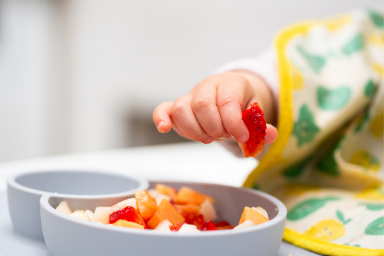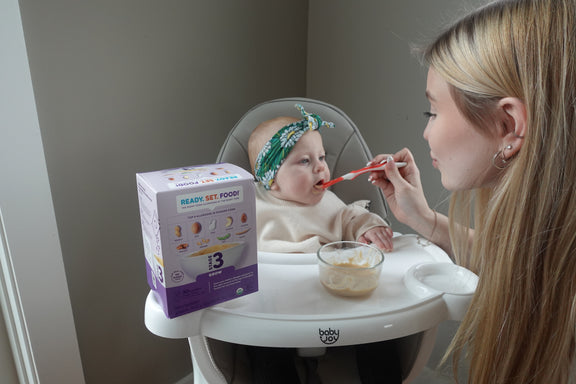Erin Moore, Nurse Practitioner and Certified Lactation Counselor, provides a comprehensive guide on pureed baby food.
Feeding your baby is one of the most exciting and sometimes overwhelming parts of parenting. Around 6 months, your little one transitions from exclusive breastmilk or formula to the exciting world of food – there are so many foods to choose from and multiple different approaches to starting solids. Because of the immense amount of information online, it can be hard to know what to trust.
One of the first questions parents have is if they should offer purees or finger foods. Purees are a more traditional way to introduce solids, however baby-led weaning, offering age-appropriate finger foods that are modified for babies, has risen in popularity.
Whether a family chooses purees or baby-led weaning, it is important for parents to focus on providing their baby with a variety of textures and flavors between 6 to 12 months. This guide will walk you through everything you need to know about pureed baby food, from making your own to understanding the different stages and how to use purees to safely introduce allergens.
What is pureed baby food?
Purees are smooth, mashed versions of fruits, vegetables, and sometimes meats, specially prepared for infants who are just beginning to eat solids. They provide essential nutrients and are easier for babies to swallow and digest.
Pureed foods are prepared by cooking and blending a food using water, breastmilk, formula or other liquids. The consistency ranges from easily running off a spoon to thick with soft chunks of food. Purees often give parents the opportunity to control texture progression with their baby.
Pureed baby food offers an in-between for babies before starting on finger foods. It allows for a more gradual approach from breastmilk or formula to family meals.
Homemade Purees vs Store-bought Baby Food
One of the first decisions you'll face is whether to prepare homemade purees or purchase store-bought options. Both have their advantages and drawbacks.
Homemade Purees
Pros of homemade purees:
- Control over ingredients: When you make purees at home, you have complete control over what goes into your baby’s food. You can choose the texture and flavors of different foods based on your baby’s eating habits.
- Cost-effective: preparing purees at home can be more economical, especially if you buy fruits and vegetables in bulk or use produce from your garden.
- Can modify the food you are eating: You can save time by pureeing food your family is eating. Sometimes it seems weird, but your baby likely won’t mind a pureed hamburger and sweet potato mixture (I know mine didn’t!)
Cons of homemade purees:
- It takes more time and thought: preparing, cooking, and pureeing food can be time-consuming, which might be challenging for busy parents.
- Storage and shelf life: homemade purees need to be stored properly and typically have a shorter shelf life compared to commercial baby foods.
Store-bought Purees
Pros of store-bought purees:
- Convenience: Store-bought purees are ready to serve, which can save time and effort. They are especially handy for travel or when you're on the go.
- Variety: There is a wide range of flavors and combinations available. There are many brands out there at a variety of price points. You can find foods your baby might not eat otherwise because your family does not eat them.
- Safety standards: Commercial baby foods are produced under strict safety regulations, ensuring they are free from harmful bacteria and contaminants.
Cons of store-bought purees:
- Cost: Pre-packaged baby food can be more expensive than making your own.
- Flavor: Some store-bought purees may be fruit forward and sweet.
- Requires extra thought: Some purees have textures that are thicker or thinner, but it may be difficult to find purees that have more complicated textures.
Baby Food Stages
What are the baby food stages?
Baby food stages were invented as a way to help parents easily introduce foods and progress in variety.
- Stage 1 baby food consist of single ingredient smooth purees that easily roll off the spoon
- Stage 2 purees are often thin in consistency and have two to three ingredients
- Stage 3 purees often have multiple ingredients and may be thicker or have added texture
- Stage 4 are often marketed toward toddlers with increased calories and variety
The American Academy of Pediatrics recommends introducing a new food every 3-5 days, though some families choose to introduce new foods sooner.
Pureed Baby Food Storage
Proper storage of pureed baby food is crucial to maintain its safety and nutritional value. Here are some tips for storing homemade and store-bought purees:
Homemade Purees
Refrigeration:
- Store purees in airtight containers and refrigerate immediately.
- Homemade purees can be kept in the refrigerator for up to 48 hours.
Freezing:
- Freeze purees in small portions using ice cube trays or silicone molds. Once frozen, transfer the cubes to a labeled freezer bag.
- Purees can be frozen for up to three months.
- To thaw, place the desired amount in the refrigerator overnight.
Store-bought Purees
- Unopened jars or pouches can be stored at room temperature in a cool, dry place.
- Once opened, store in the refrigerator and use within 24-48 hours depending on the brand
How to use purees to introduce allergens
Introducing allergens to your baby’s diet can be a nerve-wracking process, but it is essential for preventing food allergies. Current guidelines recommend introducing allergens early and often, starting around 4-6 months, alongside other solid foods.
Consider the following ways to add allergens into purees:
- Mix a single-ingredient nut butter with a food your baby already tolerates (tree nuts)
- Use whole fat yogurt, cottage cheese or mascarpone to add flavor and texture into purees (milk)
- Add ground bread crumbs into purees for extra texture (wheat)
- Mash in a small amount of hummus (sesame)
- Puree or mash soft tofu into a puree (soy)
- Scramble egg and mix with pureed food (eggs)
Alternatively, you can use Ready. Set. Food! Organic Purees, which takes the guesswork out of how to keep allergens in your baby’s diet.
This first-of-its-kind puree contains the top 3 most common food allergens - peanut, egg, and milk - already inside. RSF! purees make it easier to follow guidelines recommending the importance of introducing and maintaining exposure to top allergens in your little one's diet.
All three flavors are organic and made with no artificial ingredients or added sugar. They have also received the Clean Label Project Purity Award.
Safety Tips for Allergen Introduction
- Consult your pediatrician before introducing allergens.
- Introduce one allergen at a time and wait three to five days before trying another. Watch for any signs of an allergic reaction, such as rash, swelling, vomiting, or diarrhea.
- Start with very small amounts and gradually increase the quantity as your baby tolerates it.
- Use a step-wise approach to introduce the perfect amounts of the most common allergens like the RSF mix-ins.
Introducing your baby to pureed foods is an exciting time, but it can also feel scary. Whether you choose homemade or store-bought purees, understanding the different stages of baby food, proper storage techniques, and how to safely introduce allergens are key to ensuring your baby’s nutritional needs are met. By providing a variety of flavors and textures, you can help your baby develop a love for food.

The Window Of Opportunity For Introducing Peanut: New Study Findings From the LEAP and EAT Trials
Results from the landmark LEAP and EAT studies have shown that intr...

Best Finger Foods For Babies (And When To Start Finger Foods)
When to move beyond the spoon and start baby's journey with finger ...

6 Reasons Why You Should Introduce Allergens
Landmark studies and medical guidelines recommend that you introduc...

7 Ways to Feed Your Toddler More Iron
Iron is an essential mineral for your toddler’s brain health and ov...

How To Know If My Toddler Is Getting Enough Protein?
Protein supports your toddler’s growth, helps build strong bones an...

How Much Milk Should Your Toddler Drink?
How much milk should your toddler drink in a day? Find out the reco...
All health-related content on this website is for informational purposes only and does not create a doctor-patient relationship. Always seek the advice of your own pediatrician in connection with any questions regarding your baby’s health.
These statements have not been evaluated by the Food and Drug Administration. Products are not intended to diagnose, treat, cure or prevent any disease. If your infant has severe eczema, check with your infant’s healthcare provider before feeding foods containing ground peanuts.






